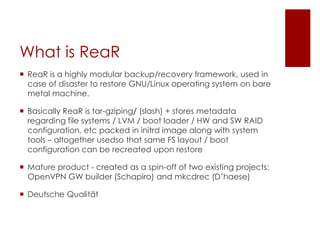Rear
- 1. ReaR AleksandarBilanovic LHS Telekommunikation
- 2. What is ReaR ? ReaR is a highly modular backup/recovery framework, used in case of disaster to restore GNU/Linux operating system on bare metal machine. ? Basically ReaR is tar-gziping/ (slash) + stores metadata regarding file systems / LVM / boot loader / HW and SW RAID configuration, etc packed in initrd image along with system tools ¨C altogether usedso that same FS layout / boot configuration can be recreated upon restore ? Mature product - created as a spin-off of two existing projects: OpenVPN GW builder (Schapiro) and mkcdrec (DˇŻhaese) ? Deutsche Qualit?t
- 3. Why ReaR ? Open source software written in shell using standard UNIX utils - can easily be modified to suit environment needs ? Fast ¨C both backup and restore operation ? Online ¨C no service interruption during backup ? Space efficient ¨C only effective data is being backed up ? Can be easily modified for specific needs and extend with new features ? Can restore to another (similar) hardware ¨C hence system cloning is possible ? Can also be used to manually restore individual files ? Can backup / restore to different backend storage (TSM, NFS)
- 4. Why not ReaR ? Does not work for Linux systems older than ~ 10 years (<2.6) ? Can work only if systems are on the same broadcast domain (on PXE based bare metal restore) ? Can fail in heavily customized GNU/Linux installation
- 5. Our modifications ? Patched sshd.conf/passwd to permit remote root logins ? Disk geometry fix patch ? grub.conf fix patch ? MAC addressed list also included in backup meta data ? DHCP/manual IP address assignment during restore (restore in different network)
- 6. Managing backups ? There wasnˇŻt free tool for managing backups ¨C so we wrote our own: ? rearadm ¨C ruby scrip (easy to understand ¨C clean code) ? ~ 1000 lines (including integrated man pages) ? archiving, versioning and deleting backups ? creating, changing and deleting hosts ? provisioning backups for restore procedure ? cloning systems
- 7. Demo ? ReaR installation & configuration ? creating backup ? managing backup ? archiving ? provisioning backup for restore/cloning
- 8. Time for you Q/A








